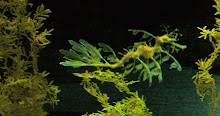Image of the week this week is this picture of Horseshoe crabs that I took during my recent trip to London Aquarium.

Limulus polyphemus Image by V. Neblik, 2010. (Copyright V. Neblik, 2010, all rights reserved)with thanks to London Aquarium.
These creatures- more closely related to spiders than crabs have a number of weird attributes- not least their blood, which is literally blue and spider-like "book-lungs". The reason for their blue blood is that, like the blood of molluscs and some arthropods- it contains a copper-based compound- haemocyanin- which transports oxygen and carbon dioxide, rather than haemoglobin, which fulfils the same function in human blood (and which gives our blood its characteristic red colouration). More information on this particular species-Limulus polyphemus- can be found here- http://en.wikipedia.org/wiki/Limulus_polyphemus )
I am probably one of only a small number of individuals to own one of these creatures, having been given the body of one some years ago by a Canadian icthyologist friend. It is a fascinating, if slightly grisly, gift. My friend had found it dead on the seashore many years prior to that, yet, the creature is in pristine condition despite never having been preserved. I find this surprising - insects keep very well without preservation, but the body of the horseshoe crab is fairly fleshy, underneath its exoskeleton, so it is interesting (to me, at least) that it remains so well intact.
Science Update.
The big science news this week also has a marine theme- it is the story of the enormous oil-spill in the gulf-of Mexico. The best article I have seen on this in the last few days is this one-
http://news.yahoo.com/s/livescience/20100504/sc_livescience/hurricaneseasoncouldhaltoilspillcleanup
One possible solution to the problem, which, oddly, has received no coverage so far, would seem to be that of seeding the spill with large quantities of the oil-slick-eating bacterium A. borkumensis. You can find out more information on this wonderful marine germ here- http://ezinearticles.com/?Bees-and-Bacteria&id=2883002 - this is an older article (the relevant section is towards the end of the article).









Intersting about the bacterium. Have you forwarded this idea to the relevant people. Sometimes what you think of as obvious may not be to others and they may not have thought of it.
ReplyDelete